Arrival in Japan from Nepal
April 27th, 2005 at 4:37 am
So I had been living in Nepal for 5 months when everything changed. I woke up on February 1 to find all the telephone lines dead, the electricity sporadic, internet cut off, and all the cable TV channels dead. All except channel 3. Channel 3 was broadcasting a pre-recorded message from the king of Nepal. The message told us that he had declared a state of emergency and dissolved all government entities.
A picture of the King on TV (Feb 2, 2005)
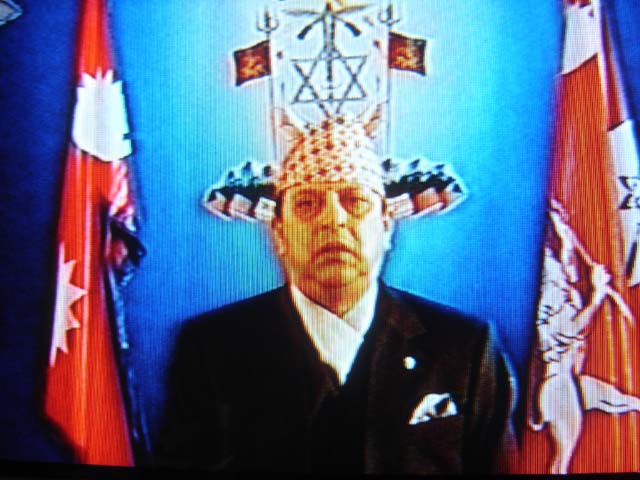
It was a big step backwards for Nepal. Politicians had been kidnapped, murdered, or placed under house arrest. The previously free press was now being filtered by the monarchy/dictator. All flights were cancelled because foreign states no longer recognized Nepal as a legitimate state. This was further complicated by the Maoist insurgency that had been going on for almost a decade. The Maoists had gained ground in past months, and almost all of Nepal outside Kathmandu valley was under Maoist control. They had used bombs, arson, execution, and rape as means to gain control of Nepal. Now that there was no government, the police and army seemed to have disbanded in favor of the palace guards. Of course with no news, it was hard to know what was going on. The US embassy was offering 1-2 week mail service, but that seemed useless. My friend, Julie, who worked at the Danish embassy got me in to use their satellite internet. I sent an emergency email out to everyone, and within 24 hours I had made the decision to leave Nepal as soon as I could.
Unfortunately, the airport was closed and any vehicles outside Kathmandu valley were being shot at and bombed. So for the time being all foreigners were stuck. We all bided our time, and the rumors circulated by word of mouth. 1 week later the telephones were turned back on, and electricity had become consistent in my neighborhood (the embassy district). A few days later some daring internet cafes went back online. As soon as I had internet, I started planning my next move. I had planned on staying in Nepal for up to a year, so changing plans at this point wasn’t easy.
After much deliberation on if I could afford more travel, or if I would have to find a job, I decided to look into a job. I was in Asia, and didn’t want to stray too far, but this meant prohibitively low wages for work. To earn any savings, I would have to work in a developed Asian country (Hong Kong, Japan, Singapore) or find work with a multi-national. Well, after talking to some ex pats in Kathmandu, it seemed less feasible that an American company would hire me from Nepal with limited or no expertise in operations. It was still possible that Dell needed Americans in their Indian branches, but it seemed like a long distance to travel on a whim. Hong Kong and Japan, on the other hand, had a reputation for paying well for American English teachers. I started looking into both, and narrowed my search down to Japan pretty quickly (too much competition on the small islands of Hong Kong).
Japan seemed to have a thirst for English teachers that just couldn’t be quenched. There were over 6,000 English schools in the relatively small space Japan has. Some were huge chains, but most were small-time operations. I wasn’t going to risk it with a small time operation, so I started researching the big chains. They seemed pretty strict, and eventually they all ruled themselves out, save one. The only problem with these big schools is that they do not accept applications from outside America, England, and Australia. So to get the job I would have to go BACK to America. Well, that would be a nice break to meet up with friends and family and share my stories. And lucky for me, airfare out of Nepal is cheap, and my father has a nose for cheap tickets in the US. It took quite a few days to work out the details, and things in Nepal had settled down so there didn’t seem to be as much of a rush. The airport had re-opened and everything except mobile phones were back up and running. After a week of “goodbye’s”, buying a boat-load of souvenirs, and my first ever suitcase to hold it all, I booked my flights. I got cheap tickets from Kathmandu to Hong Kong for a night, and then to Tokyo for 5 days ($440 one-way) before continuing to Boston via Chicago ($800 RT). I made intentional stop overs so I could hang out in these cities on my way.
Hong Kong was great, as ever. It is one of my favorite cities in the world. A futuristic fusion of hi-tech wealth, and desperate overpopulation. Ben Mezrich captured the wealthy side in his non-fiction, Ugly Americans:
|
“Nathan Road, two blocks from Hong Kong harbor, in the heart of Kowloon. A thirty-story sky-rise hotel towering over the city’s posh Golden Mile, a stretch of high-end retail shops, five-star restaurants, luxury hotels, and throbbing yuppie discotheques. A place of immense wealth, a coming together of West and East amid a common ground of excess, hubris, and bold-faced consumerism. Asia, but not Asia, a cosmopolitan, upscale city like New York or Tokyo but with a Chinese twist, a multicultural melting pot minus the tired and hungry and poor, a place lodged in history but reborn in a wash of fresh currency and overwhelming commercialization. “Hong Kong, Kowloon, the Golden Mile. From the moment Malcolm had stepped off the airplane, he’d found it difficult to catch his breath. The energy was unbelievable, as in New York or Tokyo, but even more fast paced, more hectic, just, well, more. Like Tokyo, it was a modern city of neon and winding, narrow streets, but with a Chinese twist, the addition of open air markets and seemingly dangerous back alleys and an ever present crush of people. Like New York, the city itself had been built on the vertical, buildings rising high above the harbor, the top floors lost in a soup of thick cloud.” |
I had learned it very well in my last trip, and only had 1 night, and no reservations, but I knew where to go and had a list of things to shop for. So I rushed around between Kowloon and Hong Kong Island to check into my “Blade Runner” hotel and buy some cheap electronics and cheaper food.
The next morning I was off to Tokyo on my first double-decker 747 flight ever! Woo-hoo!!
Second level of 747!!
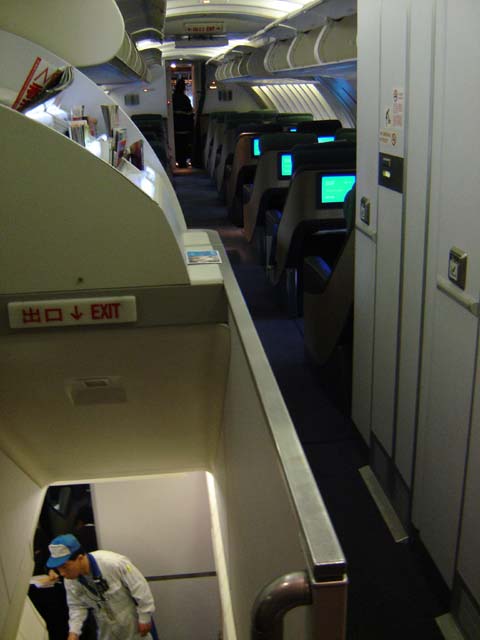
I arrived in Tokyo and of course had my enormous suitcase thoroughly searched due having come from Nepal. But the customs agent was insanely apologetic. If anything, he seemed curious for curiosities sake on what various things were. The fact that I had dumped all my pills (various shapes, sizes, and colors) into one bottle which I then duct-taped a hand-written label onto, didn’t seem to bother him at all. He was pretty interested in my Hindu God masks though. I have come to learn that this was quite possibly just a curiosity in a Gaigin (non-Japanese) coming through his gate.
This is always my favorite part of a new city. After arrival, the challenge is to learn the telephone system, subway system, money system, maps, language, and any cultural rules you might not want to go against (in Japan, don’t blow your nose in public, walk on the left just like the cars, don’t ask direct questions, pay using both hands, ATM’s don’t exist, mobile phones off in public places like the train, never wear your shoes into the bathroom, etc). And you have to do it all, pretty much right away. My biggest stump that day was actually the subway system. I looked at the map at Narita airport for 20 full minutes. Many people offered to help, but I just kept saying, “no thanks, I’ve got to learn it eventually anyway.” Basically, the system is fucked. There are (I think) 5 companies in Tokyo, and none of them like to share their maps with others, so often times you have to consult at least 2 different station maps just to get an idea of your options. Thankfully many stations have maps with English characters also. So the first thing you have to do is find your station name on the map. Then you’ve got a bunch of colored lines (optional subway lines) connecting various other station names. Under each of the other subway names are 2 numbers. One is the ticket price to get there. Probably the higher one. Now, if you’re lucky enough to find the right map with BOTH your station name AND your destination station name, you are probably standing in front of the ticket machine also. The machines are baffling when first seen. It is simply a monitor with about 40 black, unmarked buttons underneath it. It took the observation of many other people to figure out that only after you insert your money do the buttons start to light up with numbers on them (depending on how much money you put in). After the obligatory picture of the map and computer I made my way to the platform. I have no idea what train I got on, but only after many station transfers and elevators to sub-platforms somewhere in Tokyo, did I make it to my final station - 3 hours later (1 1/2 hours later than I said I’d be there). Of course I had chosen the wrong ticket amount, so I couldn’t even get out of the station without paying a station attendant extra.
Of course my “easy to find” hostel was anything but easy when you exit the station from the wrong tunnel. So after some experimenting with a new pay phone I reached them and they guided me to their front door. I could barely fit my hulking body, never mind my suitcase into the closet-of-a-hostel. No really. My suitcase didn’t even fit in the front door. I had to leave it in their garage with everyone else’s suitcases! The people there were super nice and friendly and my room was awesome (though I had to duck and walk sideways to get in and about my room). I quickly learned another cultural gem of the Japanese. They don’t believe in heating. They prefer to wear warm clothes. But it’s not quite what you think. They literally DON’T want heating. So much so that though it was snowing outside, the windows were all wide open. I closed my window in my room, but every time I came back, someone had opened it again. Well, that just wouldn’t do. I had just come from Nepal and simply didn’t have the right clothes for a snowy climate.
Luckily I was saved from a freezing night of sleep buy 2 Aussie’s. Now if you know anything about Aussie’s abroad, you know they are party animals. So it was a given that they’d be looking for a good party that night. Well, as it happens, so was I. So before I knew it we were on our way to Roppongi, the hedonistic capitol of the world. The weird thing about Tokyo is that, despite it’s size (about 10 New York Cities, I think), the subways systems all close at midnight. And taxis in Tokyo can easily reach over US$100. So if you go out, you’re out for the night… which was all the same to me. We arrived in Roppongi only to be approached by an African scout. Now, coming from where I did, I didn’t trust this guy as far as I could throw him, but the 2 Aussie’s were F.O.B. so they were all smiles and “thank you’s”. I kept saying “no, we aren’t going with you. If you want to come with us to 911, you can.” Eventually he said he’d come with us, which didn’t seem like a good thing to me. But basically he just wanted free drinks so he showed up as if he hustled us and took off to get his free beer. The rest of the night was a little less than I had hoped for actually. The Aussie’s split pretty soon in search of T&A, and I was becoming aware of how much of a tourist magnet this area was. It wasn’t the crazy Tokyo night scene I had come to expect from Lost in Translation. It was just hundreds of other Gaigin in search of the same thing. It was like being at a party and realizing it’s just a cock-fest. Everyone was there for Japanese girls or culture that was most definitely somewhere else. I later read about Roppongi and got the impression the area is a has-been. The action has moved on somewhere else in search of an underground, less gaigin-exploited area. I don’t blame it. I ended up wandering from club to club just to see what they were all like (knowing full-well I would probably never go back to Roppongi again). They all sucked the big one.
By 5am I had returned to 911 which at least had people, and since I hadn’t been dancing very much I put on a big show of how much energy I had. I felt uncomfortable after approached by a Japanese girl who was either a professional dancer, or just a good dancer on speed. She showed me up for about a minute and then walked off. I suspected that could have meant something, but I didn’t know what, so I left.
The streets were full of African hustlers, furyu gaigin (reject foreigners), drunk salarymen (business men), and yanqui girls (cheap bleach-blonde Japanese girls). There was nothing for me there, and I was a little disappointed in my would-be night of debauchery. I still had to wake up early if I wanted to make the most of my time in Tokyo before heading back to the US. I made it home by 6am, and got 4 hours rest next to the perpetually-open window.
The next day was my first full day in Tokyo. I had purchased a Lonely Planet Japan while I was in nepal, and it was obviously hopeless to see all of Tokyo in such a short time. But I started tackling neighborhoods one at a time. I started with the area my hostel was in. It’s name is Asakusa (pronounced AH-SAH-KSAH), and it has an interesting history. It was one of the first colonial hot-spots in Japan, with the first movie theater and brothels. Now it’s only known to tourists (Japanese and gaigin alike) for the Senso-ji temple. This was my first temple in Japan, and I thought it was pretty cool. Way better than Chinese temples. Lots of ceremony involved also. First you have pass under a temple gate, followed by a long street with lanterns on either side.
After a second gate you enter the temple courtyard. Before you can do anything, you must go to the temple fountain, and clean your hands and mouth (essentially holy water). Then there is a large incense cauldron which everyone stands around to bath in the smoke (a cleansing).
Incense Cauldron
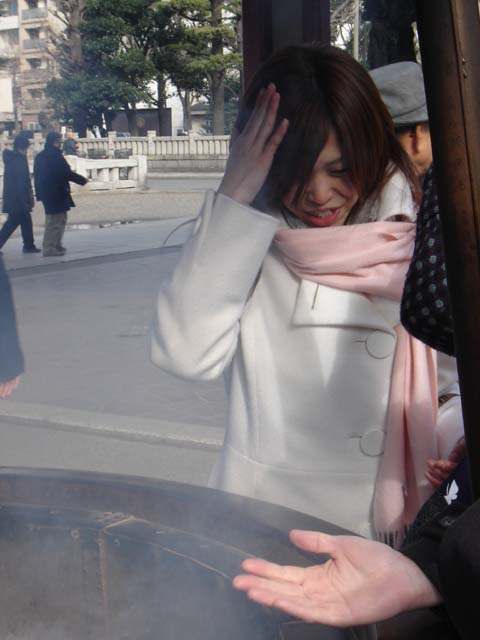
Only then can you approach the temple. When you approach, you are supposed to do a series of clapping and bowing. Upon final approach you throw a coin into a gated box, and ring a bell hanging above the main door. When you are finished you back away. On their way out of the temple many people tie prayers to the fence and special prayer areas.
Prayers
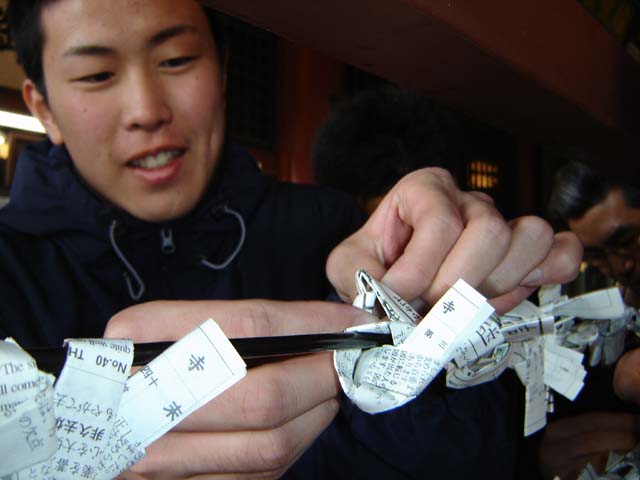
After the temple I walked out of Asakusa to Ueno. Ueno is one of the last areas of Tokyo that has fought the modernization and vertical development that came with post-war Tokyo and the bubble years of the 80’s. It still has cheap eats, and grimy shopping alleys under the many bridges that have been built over it. It also has a huge park that houses the highest concentration of museums in all of Japan. LP recommended the Tokyo National Museum, so I popped in for a stroll. It was pretty good, and covered all sorts of styles and periods. Most people seemed to be packed into the Samurai sword room, but they all looked the same to me, and I didn’t know any of the famous Samurai names on the swords, so I found myself most impressed with the Samurai armor exhibit. Scary stuff!!
Samurai Armor
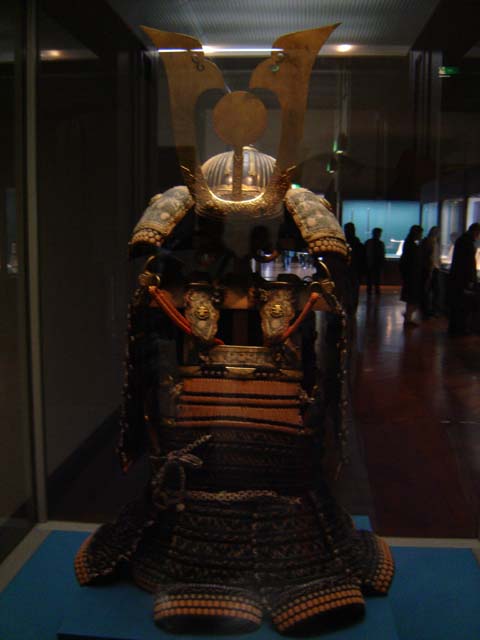
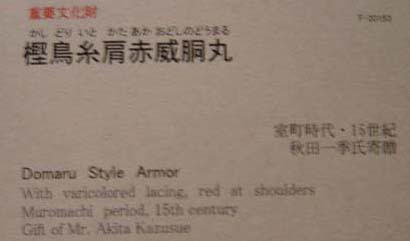
It was in the bathroom, though, that I found the most exciting thing at the museum. It was here that I had my first Japanese toilet experience! Japanese toilets are unlike anything you’ll find outside Japan. Again, I quote Ben Mezrich (Ugly Americans) as he describes his first experience with a Japanese toilet:
|
“The consol in front of me looked like the control panel of a 747, except the instructions were all in Japanese. The small room had a similar cockpit feel, but the walls were laced in chrome, and the floor was sparkling black marble, polished so brightly it matched the glow of the florescent ceiling strips. “The seat beneath me was vibrating softly, the cushiony material warmed electronically to my exact body temperature. I surveyed the dials, knobs, and buttons on the console using tiny pictures above the Japanese script to make out the controls of a DVD player, a CD changer, and something that was either a sophisticated remoter control bidet or a miniature geyser. I finally found a small red button that seemed promising and hit it with two fingers. The familiar sound of a toilet flushing echoed off the marble floor. It took me a full second to realize the sound was synthetic, like just about everything else in this futuristic place; the space aged toilets mechanisms were actually whisper silent, the audible flush had been added separately to coddle the expectations of anxious foreigners like me. “Seconds later, I watch the toilet-seat cover close auto matically, readying itself for the next customer. I shook my head, amazed. I’d always believed you could tell a lot about a culture from its toilets. In Europe, the toilets were little more than holes in the ground, symbols of a continent mired deeply in the past. In America, there were sturdy white bowls with masculine, military industrial flushing power. No frills or frosting. Pure utility. Here, in Tokyo, the toilets were magnificent constructs of advanced technology. It was a society moving quickly into the future, as impersonal and whisper silent as that future might be.” |
Toilet Flusher Computer at Museum
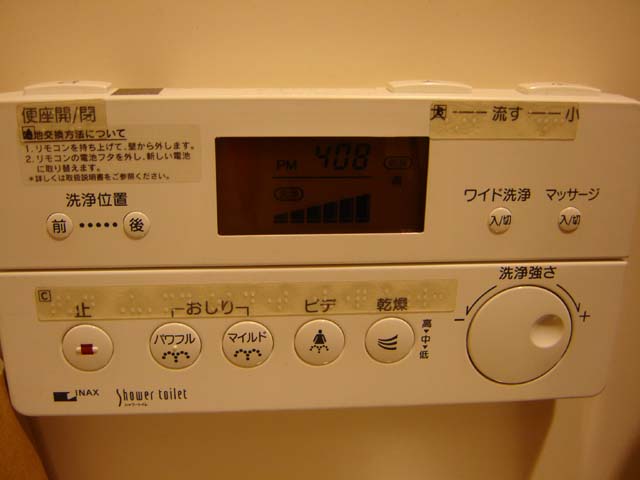
After a jaunt through the nice Ueno-koen (Ueno Park), I caught the subway to Shinjuku - the stereotypical Tokyo. Neon lights, 20-story TV screens, human traffic, taxi traffic, touts, noise. It’s the Times Square of Tokyo, only bigger. Much bigger. It’s a whole district of Tokyo - a city, technically. It stretches out into the surrounding hills, up into the towering skyscrapers around you, and down into underground malls, tunnels, and hallways many levels below the street. It’s 50 times the size of Times Square, and has the busiest train station in the world at 2 million people per day!!! For those of you in Boston, that would mean everyone in Boston would have to squeeze through that one station four times per day!!
I had wanted to go to the top of the famous Government Buildings. Actually they are only famous because they are the tallest free skyscrapers in Tokyo. But after walking, and walking, I just couldn’t find them. I’m really good with maps, but in Tokyo it can be hard when you exit a subway to get your bearings. They don’t name their streets in Japan, and a lot of the areas are just so jam-packed with buildings, that you can’t make any reference point. So I gave up, but eventually just happened to walk by another place I wanted to see: The Pentax company museum. It had some really cool old cameras, and of course all the most expensive crazy high-tech new stuff. Best part was that the new stuff was hands on! Fun for me!
I eventually made it to another part of Shinjuku, but to be honest, it was just such a big part of the city; I gave up before exploring the truly famous Kabuki-cho. You might think this has to do with Kabuki theater (the strange old Japanese style opera), but you’d be very wrong. Maybe once it was known for that. But now it’s apparently the red light district. Well, I would have to wait for another time to see what that’s all about in Japan. Instead I ducked into the massive Shinjuku station and made it back to my hostel in Asakusa.
(to be continued…)